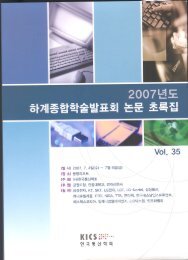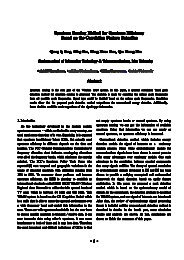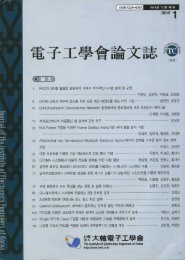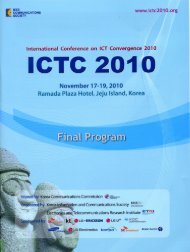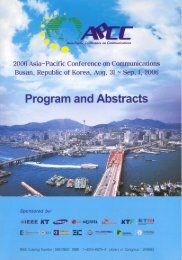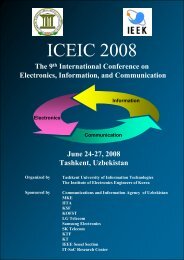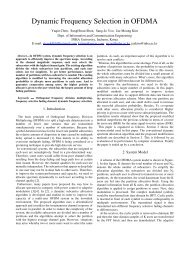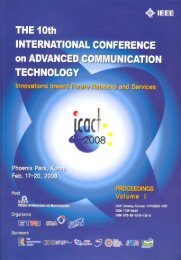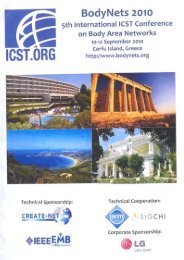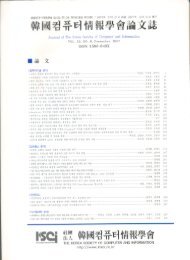스펙트럼 상관관계를 이용한 ATSC 지상파 DTV의 고속 주파수 동기 방법
스펙트럼 상관관계를 이용한 ATSC 지상파 DTV의 고속 주파수 동기 방법
스펙트럼 상관관계를 이용한 ATSC 지상파 DTV의 고속 주파수 동기 방법
Create successful ePaper yourself
Turn your PDF publications into a flip-book with our unique Google optimized e-Paper software.
(a) Rayleigh(120km/h)에서 기존 FPLL <strong>동기</strong> 성능<br />
(b) Rayleigh(120km/h)에서 제안된 FPLL <strong>동기</strong> 성능<br />
그림 17. Rayleigh(120km/h) 채널에서의 NCO제어입력신호<br />
Fig. 17. NCO input control signal in Rayleigh(120km/h) channel<br />
를 줄일 수 있게 된다. 그림 16과 그림 17는 이동<br />
수신 환경인 레일리 채널에서 속도에 따른 <strong>ATSC</strong><br />
<strong>주파수</strong> <strong>동기</strong> 성능을 나타낸다. 그림 7의 이동 수신<br />
채널의 <strong>주파수</strong> 특성 곡선에서 볼 수 있듯이 이동<br />
수신 채널에서는 브라질 채널에 비해 작은 전압을<br />
가지고 있고 수렴 범위도 작은 것을 알 수 있다. 따<br />
라서 시뮬레이션 시간인 4ms에서 전혀 수렴되지 못<br />
하고 있는 것을 볼 수 있다. 하지만 제안된 <strong>방법</strong>에<br />
서는 이동 수신 채널에서도 상관관계의 특성이 좋<br />
기 때문에 넓은 수렴 범위와 매우 빠른 수렴 속도<br />
를 가지게 된다.<br />
Ⅴ. 결 론<br />
<strong>ATSC</strong> <strong>지상파</strong> DTV 시스템에서 규정한 파일럿<br />
신호를 사용하는 기존 FPLL 방식은 채널에 의해<br />
신호가 왜곡되면 파일럿 신호와 파일럿 주위의 스<br />
펙트럼 모양이 왜곡되어 <strong>주파수</strong> <strong>동기</strong> 성능의 열화<br />
를 가져온다. 하지만 제안하는 <strong>스펙트럼</strong> <strong>상관관계를</strong><br />
<strong>이용한</strong> <strong>동기</strong> <strong>방법</strong>은 파일럿을 이용하지 않고 기준<br />
<strong>주파수</strong>와 채널 통과 후 <strong>주파수</strong>와의 상호 상관관계<br />
를 가지고 <strong>주파수</strong> 옵셋을 추정해내기 때문에 파일<br />
럿 신호에 의존하는 기존 <strong>주파수</strong> <strong>동기</strong> 알고리즘에<br />
비해 <strong>주파수</strong> <strong>동기</strong> 수렴 범위를 늘려주고 수렴 속도<br />
Copyright (C) 2005 NuriMedia Co., Ltd.<br />
논문 / <strong>스펙트럼</strong> <strong>상관관계를</strong> <strong>이용한</strong> <strong>ATSC</strong> <strong>지상파</strong> <strong>DTV의</strong> <strong>고속</strong> <strong>주파수</strong> <strong>동기</strong> <strong>방법</strong><br />
를 빠르게 할 수 있다. 이는 이동 수신 채널 환경에<br />
서도 그대로 적용되어 <strong>ATSC</strong> 시스템의 이동 수신에<br />
대한 <strong>주파수</strong> <strong>동기</strong> 문제도 해결 할 수 있게 된다.<br />
FFT 사이즈를 넓혀주면 좀 더 정확한 옵셋 추정이<br />
가능하고 이후 루프 필터등을 결합하면 기존의 파<br />
일럿을 사용하지 않는 새로운 <strong>동기</strong>방식으로 빠르고<br />
정확한 <strong>동기</strong>를 획득할 수 있을 것이다.<br />
참 고 문 헌<br />
[1] <strong>ATSC</strong> A/53, <strong>ATSC</strong> digital television standard,<br />
Sep. 1995.<br />
[2] <strong>ATSC</strong> A/54, Guide to the use of the <strong>ATSC</strong><br />
digital television standard, Sep. 1995.<br />
[3] Gary Sgrignoli, Wayne Bretl, and Richard<br />
Citta, “VSB Modulation Used for Terrestrial<br />
and Cable Broadcasts.” IEEE Trans. on<br />
Consumer Electronics, vol.41, no.3, pp.367-<br />
382, Aug. 1995.<br />
[4] R. Citta, “Frequency and Phase Lock Loop,”<br />
IEEE Trans. on Consumer Electronics, vol.23,<br />
no.3, pp. 358-365, Aug. 1997.<br />
[5] Young-Jae Ryu and Dong-Seog Han,<br />
“Frequency synchronization algorithm robust<br />
to pilot distortion in <strong>ATSC</strong> system,” IEEE<br />
Trans. on Consumer Electronics, vol.48, no.3,<br />
pp.610-615, Aug. 2002.<br />
[6] D.S. Han, M.H. Lee and K.H. Park,<br />
“Development of a Digital FPLL ASIC for<br />
GA HDTV Receivers.” IEEE Trans. on<br />
Consumer Electronics, vol.43, no.3, pp.747-<br />
754, Aug. 1997.<br />
[7] Zhaoyang Zhang, Yanyan Cui and Peiliang<br />
Qiu, “”A novel all digital VSB carrier recovery<br />
loop for HDTV terrestrial,” IEEE<br />
Trans. on Consumer Electronics, vol.46,<br />
no.2, pp.265-269, May, 2000.<br />
[8] Yiyan Wu, Xianbin Wang, Richard Citta,<br />
Benoit Ledoux, Sebastien Lafleache and<br />
Bernard Caron, “An <strong>ATSC</strong> DTV Receiver<br />
with Improved Robustness to Multipath and<br />
Distributed Transmission Environments,” IEEE<br />
Trans. Broadcasting, vol.50, no.1, pp. 32-41,<br />
Mar. 2004.<br />
[9] Tim Laud, Mark Aitken, Wayne Bretl,<br />
K.Y.Kwak, “Perfomance of 5th Generation<br />
865



